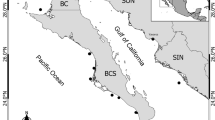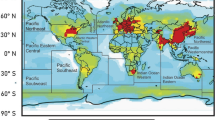Abstract
Muscle, liver, and kidney tissues from 38 polar bears (Ursus maritimus) caught in the Scoresby Sound area, Central East Greenland, were analysed for zinc, cadmium, mercury and selenium. In general, cadmium concentrations were low in muscle, liver and kidney tissue, with geometric means (g.m.) of 0.022 (range: <0.015–0.085), 0.841 (range: 0.092–3.29) and 13.1 (range: 1.04–115) μg Cd/g wet weight (ww) respectively. This finding can be explained by low cadmium levels in the blubber of ringed seals. The concentration of mercury in muscle tissue was low (g.m. 0.071; range: 0.039–0.193 μg Hg/g ww), whereas concentrations in liver and kidney tissue were relatively high (liver: g.m. 7.87; range: 1.35–24.8 μg Hg/g ww, and kidney: g.m. 15.2; range: 1.59–66.6 μg Hg/g ww). Mercury and cadmium were positively correlated with age in liver and kidney. Zinc was positively correlated with age in kidney, and selenium was correlated with age in liver. Contrary to other marine mammals, polar bears had higher mercury levels in the kidneys than in the liver. In all three tissues polar bears had significantly lower cadmium levels than ringed seals from the same area. Mercury levels were likewise significantly lower in the muscle tissue of polar bears than in ringed seals, whereas levels in the liver and kidney were significantly higher. The previous geographic trend for cadmium and mercury found in Canadian polar bears could be extended to cover East Greenland as well. Hence cadmium levels were higher in Greenland than in Canada, while the opposite was the case for mercury. Greenland polar bears had higher mercury and cadmium contents in livers and kidneys than polar bears from Svalbard. The mercury levels in muscle and liver tissue from polar bears from East Greenland were twice as high as found in bears from western Alaska, but half the levels found in northern Alaska. Cadmium and zinc were partially correlated in kidney tissue, and this was found for mercury and selenium as well. Cadmium and zinc showed molar ratios close to unity with the highest concentrations occurring in kidney tissue, while the levels of zinc exceeded cadmium in muscle and liver tissue by up to several decades. Mercury and selenium showed molar ratios close to unity in liver and kidneys.
Similar content being viewed by others
References
Andrews GK (1990) Regulation of metallothionein gene expression. Prog Food Nutr Sci 8:109–163
Anonymous (1988) Hjemmestyrets bekendtgørelse nr. 7 af 5. maj 1988 om fredning af isbjørne i Grønland
Born EW (1987) Aspects of present-day maritime subsistence hunting in the Thule area, Northwest Greenland. In: Hacquebord L, Vaughan R, (eds) Between Greenland and America. Cross cultural contacts and the environment in the Baffin Bay area. Arctic Centre, University of Groningen, The Netherlands:109–132
Born EW, Renzoni A, Dietz R (1991) Total mercury in hair of polar bears (Ursus maritimus) from Greenland and Svalbard. Polar Res 9:113–120
Bowes GW, Jonkel C (1975) Presence and distribution of polychlorinated biphenyls (PCB) in Arctic and Subarctic marine food chains. J Fish Res Board Can 32:2111–2123
Braune BM, Norstrom RJ, Wong MP, Collins BT, Lee J (1991) Geographical distribution of metals in livers of polar bears from the Northwest Territories, Canada. Sci Total Environ 100:283–299
Bremner I (1987) Interactions between metallothionein and trace elements. Prog Food Nutr Sci 11:1–39
Cirkt M, Bencko V (1989) Mercury-selenium interactions: Distribution and excretion of Hg2+ in rats after simultaneous administration of selenite or selenate. Toxicol Lett 48:159–164
Clausen J, Berg O (1975) The contents of polychlorinated hydrocarbons in Arctic ecosystems. Pure Appl Chem 42:223–232
Clausen J, Braestrup L, Berg O (1974) The content of polychlorinated hydrocarbons in Arctic mammals. Bull Environ Contam Toxicol 12:529–534
Cousins RJ (1985) Absorption, transport, and hepatic metabolism of copper and zinc: Special reference to metallothionein and ceruloplasmin. Physiol Rev 65:238–296
Dietz R (1987) Tungmetaller i isbjørne og andre arktiske dyr (in Danish and Greenlandic). Tusaat/Forskning i Grønland 2:2–13
Dietz R, Agger CT (1992) Recent studies on heavy metals in polar bears from Greenland with reference to other marine mammals. In: Niimi AJ, Taylor MC (eds) Proceedings of the Eighteenth Annual Aquatic Toxicity Workshop: September 30-October 3, 1991, Ottawa, Ontario. Can Tech Rep Fish Aquat Sci 1863:280–284
Dietz R, Nielsen CO, Hansen MM, Hansen CT (1990) Organic mercury in Greenland birds and mammals. Sci Total Environ 95:41–51
Doutt JK (1940) Toxicity of polar bear liver. Mammal 21:356–357
Eaton RDP, Farant JP (1982) The polar bear as a biological indicator of the environmental mercury burden. Arctic 35:422–425
Elinder CG (1986) Zinc. In: Friberg L, Blinder CG, Kjelstrøm T, Nordberg GF (eds) Handbook on the toxicology of metals, 2nd edn. CRC Press, Boca Raton, Fla
Grue H, Jensen B (1979) Review of the formation of incremental lines in tooth cementum of terrestrial mammals. Dan Rev Game Biol 11:48
Hansen CT, Nielsen CO, Dietz R, Hansen MM (1990) Zinc, cadmium, mercury and selenium in minke whales, belugas, and narwhals from West Greenland. Polar Biol 10:529–539
Harrison RJ, King JE (1965) Marine mammals. Hutchinson, London
Hensel RJ, Sorensen FE (1980) Age determination of live polar bears. In: Mortinka CJ, McArthur KL (eds) Bears: Their biology and management. Government Printing Office, Washington, DC pp:93–100
Holm E, Persson BRR, Hallstadius L, Aarkrog A, Dahlgaard H (1983) Radium-cesium and transuranium elements in the Greenland and Barents Seas. Oceanol Acta 6:457–462
Johansen P, Kapel FO, Kraul I (1980) Heavy metals and organochlorines in marine mammals from Greenland. Int. Counc Explor Sea, ICES CM (1980/E:32)
Julshamn K, Andersen A, Ringdal O, Mørkøre J (1987) Trace elements intake in the Faroe Islands I. Element levels in edible parts of pilot whales. Sci Total Environ 65:53–62
Koeman JH, Peeters WHM, Koudstaal-Hol CHM (1973) Mercury-selenium correlations in marine mammals and birds. Nature 245:385–386
Koeman JH, Ven WSM, Goeij JJM, Tijoe PS, Haften JL (1975) Mercury and selenium in marine mammals and birds. Sci Total Environ 3:279–287
Lentfer JW, Galster A (1987) Mercury in polar bears from Alaska. J Wildl Dis 23:338–341
Lewis RE, Lentfer JW (1967) The Vitamin A content of polar bear liver: range and variability. Comp Biochem Physiol 22:923–926
Lønø O (1970) The polar bear (Ursus maritimus Phipps) in the Svalbard area. Nor Polarinst Skr 149
Muir DCG, Norstrom RJ, Simon M (1988) Organochlorine contaminants in arctic marine food chains: Accumulation of specific polychlorinated biphenyls and chlordane-related compounds. Environ Sci Technol 22:1071–1079
Muir DCG, Wageman R, Hargrave BT, Thomas DJ, Peakal DB, Norstrom RJ (1992) Arctic marine ecosystem contamination. Sci Total Environ 122:75–134
Nielsen CO, Dietz R (1989) Heavy metals in Greenland seabirds. Medd Grøn, Biosci 29
Nielsen CO, Dietz R (1990) Distributional pattern of zinc, cadmium, mercury, and selenium in livers of hooded seal (Cystophora cristata). Biol Trace Elem Res 24:61–71
Norheim G, Skaare JU, Wiig Ø (1992) Some heavy metals, essential elements, and chlorinated hydrocarbons in polar bear (Ursus maritimus) at Svalbard. Environ Pollut 77:51–57
Norstrom RJ, Sweinsberg RE, Collins BT (1986) Heavy metals and essential elements in livers of the polar bear (Ursus maritimus) in the Canadian Arctic. Sci Total Environ 48:195–212
Norstrom RJ, Simon M, Muir DCG, Schweinsburg RE (1988) Organochlorine contaminants in arctic marine food chains: Identification, geographical distribution, and temporal trends in polar bears. Environ Sci Technol 22:1063–1071
Paludan-Müller P, Agger CT, Dietz R, Kinze KK (1993) Mercury, cadmium, zinc, copper and selenium in harbour porpoise (Phocoena phocoena) from West Greenland. Polar Biol 13:311–320
Renzoni A, Norstrom RJ (1990) Mercury in the hairs of polar bears Ursus maritimus. Polar Rec 26:326–328
Rodahl K (1949a) Toxicity of polar bear liver. Nature 164:530–531
Rodahl K (1949b) The toxic effect of polar bear liver. Nor Polarinst Skr 92
Rodahl K, Moore T (1943) The vitamin A content and toxicity of bear and seal liver. Biochem J 37:166–168
Sandell HT, Sandell B (1991) Archaeology and environment in the Scoresby Sund fjord. Ethno-archaeological investigation of the last Thule culture of Northeast Greenland. Meddr Grønland, Man & Soc 14
Sergeant DE, Armstrong FAJ (1972) Mercury in seals from eastern Canada. J Fish Res Board Can 30:843–846
Smith TG (1980) Polar bear predation on ringed and bearded seals in the land-fast ice habitat. Can J Zool 58:2201–2209
Smith TG, Armstrong FAJ (1978) Mercury and selenium in ringed and bearded seal tissue from Arctic Canada. Arctic 31:422–425
Stirling I (1974) Midsummer observations on the behaviour of wild polar bears. Can J Zool 52:1191–1198
Stirling I, Archibald WR (1977) Aspects of predation of seals by polar bears. J Fish Res Board Can 34:1126–1229
Stirling I, McEwan EH (1975) The caloric value of a whole ringed seal (Phoca hispida) in relation to polar bear (Ursus maritimus) ecology and hunting behavior. Can J Zool 53:1021–1027
Stirling I, Archibald WR, DeMaster D (1977a) Distribution and abundance of seals in eastern Beaufort Sea. J Fish Res Board Can 37:976–988
Stirling I, Jonkel C, Smith P, Robertson R, Cross D (1977b) The ecology of the polar bear (Ursus maritimus) along the western coast of Hudson Bay. Can Wildl Serv, Occas Pap 33
Tohyama C, Himeno S, Wantanabe C, Suzuki T, Morita M (1986) The relationship of the increased level of metallothionein with heavy metal level in the tissue of the harbour seal (Phoca vitulina). Ecotoxicol Environ Saf 12:85–94
Wagemann R, Hobden B (1986) Low-molecular weight metallothionein in tissues of the narwhal (Monodon monoceros). Comp Biochem Physiol 84C:325–344
Wagemann R, Snow NB, Lutz A, Scott DP (1983) Heavy metals in tissues and organs of the narwhal (Monodon monoceros). Can J Fish Aquat Sci 40 [Suppl 2]:206–214
Wagemann R, Stewart REA, Béland P, Desjardins C (1990) Heavy metals and selenium in tissues of beluga whales, Delphinapterus leucas, from the Canadian Arctic and St. Lawrence Estuary. Can Bull Fish Aquat Sci 224:191–206
WHO (1976) Mercury. Enivornment Health Criteria 1. World Health Organisation, Geneva
Zar JH (1984) Biostatistical analysis, 2nd edn. Prentice-Hall, Englewood Cliffs, NJ
Author information
Authors and Affiliations
Rights and permissions
About this article
Cite this article
Dietz, R., Born, E.W., Agger, C.T. et al. Zinc, cadmium, mercury and selenium in polar bears (Ursus maritimus) from Central East Greenland. Polar Biol 15, 175–185 (1995). https://doi.org/10.1007/BF00239057
Received:
Accepted:
Issue Date:
DOI: https://doi.org/10.1007/BF00239057




